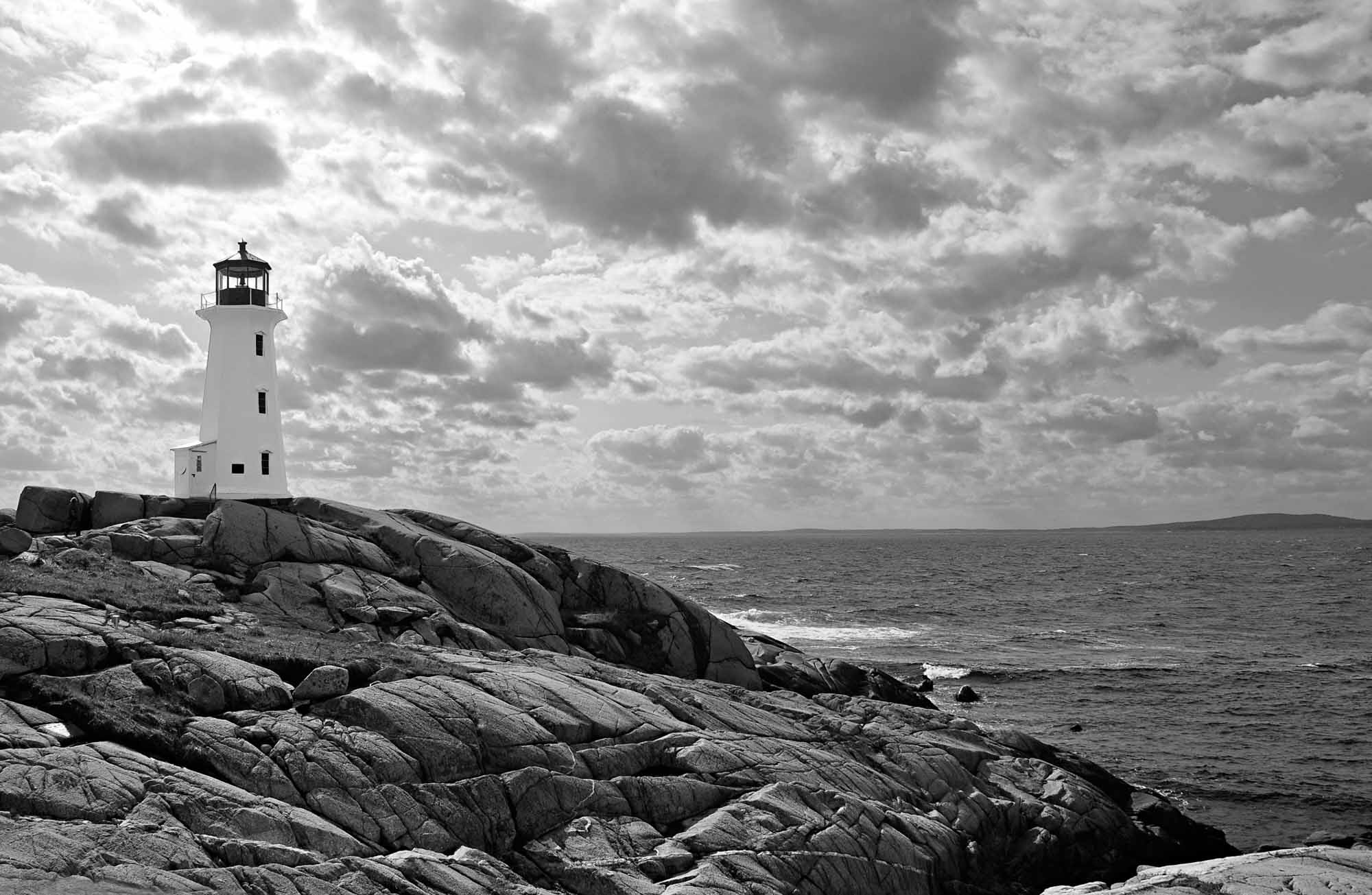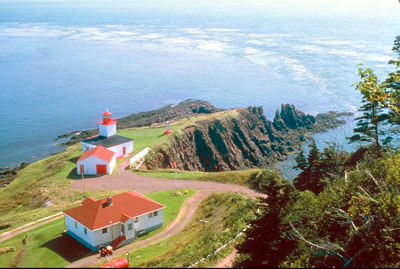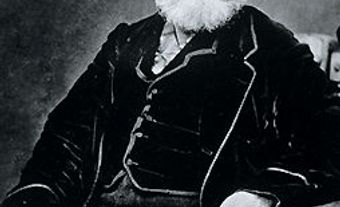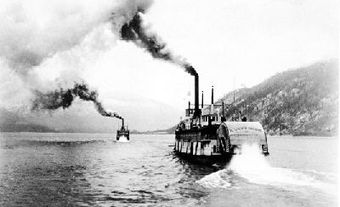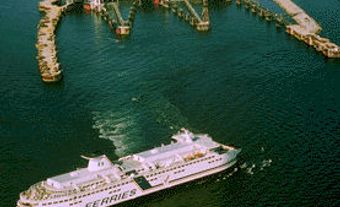Functions of lighthouses vary greatly. Great landfall lights, like those at Cape Race, Seal Island, Sambro and Race Rocks have for many years provided the first sight of land for Atlantic or Pacific travellers after days or weeks at sea. Coastal navigation is by a system of major and minor lights, and smaller lights are used on intricate waterways where numerous islands and channels need to be marked. Harbour lights and range lights mark the final approaches to safe havens.
Before the automation of lighthouses, the duties of lighthouse keepers included the traditional "keeping of the light," maintaining radio communications and beacons, tending fog alarms and providing rescue services and sanctuary. Certain stations provide regular weather observations as part of the national system, and the station at Langara in Haida Gwaii provides part of the tidal-wave warning system in the Pacific Ocean.
The first documented lighthouse, built at Louisbourg in Cape Breton in 1734, was almost immediately destroyed by fire and rebuilt. It was levelled by British guns during the siege of 1758 and rebuilt several times. The oldest existing lighthouse was built on Sambro Island at the mouth of Halifax harbour in 1758. The second-oldest surviving lighthouse was built in 1809 on Green Island (Isle Verte) in the St Lawrence River, opposite the mouth of the Saguenay.
In the early 19th century, sea trade between Canada and Europe increased rapidly and so did wrecks and disasters at sea. By 1840 major lights had been placed on Seal Island at the entrance to the Bay of Fundy, NS, at several places along the coast of Newfoundland and at the entry to the St Lawrence River. Lights were used on the Great Lakes at Mississauga (1804) and at Gibraltar Point on Toronto Island (1808). The upper Great Lakes remained in darkness until increasing trade forced the lighting of shore lamps throughout the region in the latter half of the 19th century.
On the Pacific coast it was not until 1860 that the first 2 lighthouses, at Race Rocks and Fisgard, near what is now Victoria, came into service. In the latter half of the 19th century, lights were used along the outer coast of Vancouver Island and the entryways to Victoria, Vancouver and Prince Rupert. Inland waters, such as the Saint John River, Red River and Lake Winnipeg, were marked with lights and buoys by the early part of the 20th century. In arctic waters, beacons were installed in the 1930s, with the opening of the port of Churchill.
The first lighthouses were bonfires on the ends of points at harbour entrances, later replaced by towers with similar beacons on top. Candles were used in the 18th and early 19th centuries, but it took many to make even a dim light. Oil lamps with wicks were used extensively by 1800. Eventually, whale oil and a variety of vegetable, fish and seal oils were used in different places, according to the availability of supplies and equipment.
The invention of kerosene by Abraham Gesner in Nova Scotia in 1846 led to the production of good-quality kerosene lamps, used extensively in Canada from the 1860s because they were cheap, reliable and efficient. The invention of the mantle lamp and experimentation with various oils produced lighthouses of considerable brilliance by the beginning of the 20th century. Electric lights came to lighthouses in Canada around the end of the 19th century and gradually replaced other forms of illumination.
Parabolic reflectors of polished steel or silvered copper greatly increased the effectiveness of lighthouses in the early 19th century. Reflecting systems are known as catoptric systems. Simple lens systems (dioptric) and combinations of refracting prisms and concentrating lenses (catadioptric) came into use in the mid and latter part of the 19th century. By 1800 along the coasts of Europe there were such numbers of lighthouses that it became necessary to invent a system of identifying them. An apparatus was attached to the light to produce a different pattern of flashes for each lighthouse. This sequence is noted in the List of Lights for each area. By 1890 the revolving light mechanisms were floated in mercury and driven by clockwork with great weights, which were wound up by the keeper at 2- to 4-hour intervals.
In the 1970s electrification was virtually complete. Modern mercury-vapour and xenon bulbs were so powerful that simple optics of pressed glass or plastic replaced the great revolving masses of glass and prisms. The new lamps revolved in the same way as airport beacons and lights on tall buildings. Automation has replaced the traditional lighthouse keeper. The man living with his family at a light station in a remote place has been replaced by the helicopter and the travelling technician who changes or charges the bulbs and batteries. Bulbs are changed automatically, and remote lighthouse stations are fitted with automatic standby equipment in case something goes wrong.
Between 1970 and 1996, 264 lighthouses were automated. During that quarter-century, some lighthouses that were obsolete for navigational purposes were transferred to Parks Canada, local authorities or private groups interested in protecting them. At the end of the 20th century, only one lighthouse - at Machias Seal Island - remained staffed, for sovereignty reasons.
Along Canadian coasts, where lighthouses must be seen against snow or rocks and where complicated coastlines result in many lighthouses within short distances along the shore, distinctive patterns are painted on the towers in order to distinguish them from one another. These daymarks have great variety, ranging from a red cross at Head Harbour, NB, to black-and-white horizontal stripes at Race Rocks, BC.
Construction materials vary with the time of building and local conditions. Wooden lighthouse towers are characteristic of the Canadian lighthouse service. Superb examples are to be found at East Point, PEI, Pachena on the outside of Vancouver Island, and at Gannet Rock on the entrance to the Bay of Fundy. The last, despite its exposed position, has stood since 1831.
Stone towers at Race Rocks, Cove Island (near Collingwood, Ont) and on Île d'Anticosti were built with what was available nearby and were as much as 30.5 metres high. Lighthouses were sometimes built of brick, and for a period in the late 19th century cast-iron plates were hauled ashore from ships and bolted together to produce the lighthouses at Ferryland, Nfld, and Cape North, NS. The latter is now on the grounds of the Canadian Science and Technology Museum in Ottawa.
Reinforced concrete towers were built in many places in Canada in the 20th century, the most distinctive being built around 1910, with central towers up to 30.5 metres high and with flying buttresses; examples are the beautiful towers at Father Point, Qué, Caribou Island in Lake Superior, and Estevan Point on the outside of Vancouver Island. Steel caissons are set into the riverbed at Prince Shoal and White Island Reef in the St Lawrence River, and an open-steelwork tower is on Pigeon Island in Lake Ontario. Even fibreglass towers have been tried on the Magdalen Islands and in inland waterways.
Canadian lighthouses are set in a great variety of environments - in the rain forests of the Pacific coast; in the middle of a downtown park, such as Brockton Point in Vancouver; and on the tops of high-rounded points of islands so thoroughly windswept that the lighthouses are held down by steel guy wires, as at Gull Island. Although often starkly functional in setting and design, the lighthouse has become a romantic symbol both of the country's maritime greatness and of safe haven.
However, these icons of Canada's maritime history are threatened with destruction. Their demise began with lighthouse automation, when the federal government deemed many of the older structures too costly to maintain. Dozens of lighthouses, keepers' dwellings and ancillary buildings were torn down, burned, vandalized or sold and relocated away from light station property. Since the early 1990s, preservation societies have worked to save some of Canada's lighthouses on the grounds that these structures, like railways stations and grain elevators, have special significance to Canadians and played an important role in our history. In 2008, after nearly 10 years of successive bills introduced to the legislative process, Bill S-215, An Act to protect heritage lighthouses, was passed by Parliament. In Canada, 22 lighthouses have the highest level of federal heritage protection.
According to Fisheries and Oceans Canada, there are approximately 750 structures that could be defined as lighthouses. Of those, roughly 250 are "postcard" lighthouses, some of which have protection as heritage sites. Those that are defined as "navigational aids" meet the broader definition of lighthouse. All provinces except Alberta and Saskatchewan have lighthouses, as follows: Newfoundland: 72; Nova Scotia: 160; Prince Edward Island: 56; Quebec: 59; Ontario: 104; New Brunswick: 78; Manitoba: 2; and British Columbia: 52.

 Share on Facebook
Share on Facebook Share on X
Share on X Share by Email
Share by Email Share on Google Classroom
Share on Google Classroom


